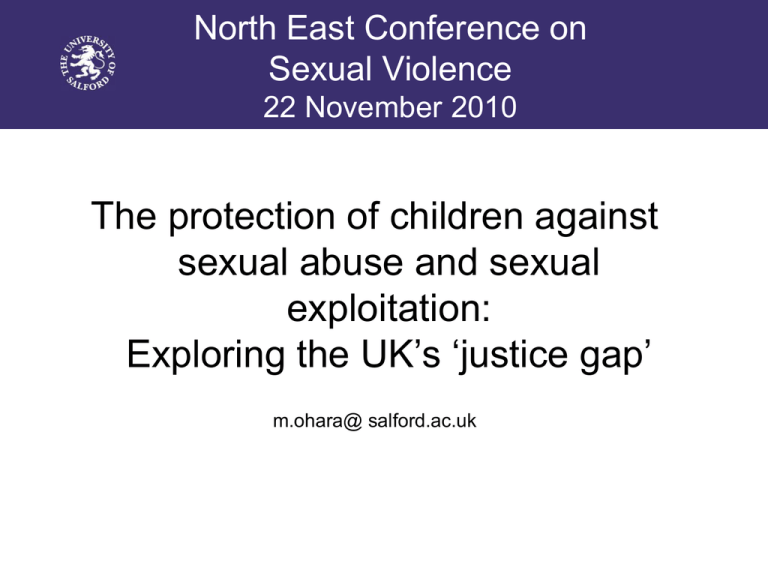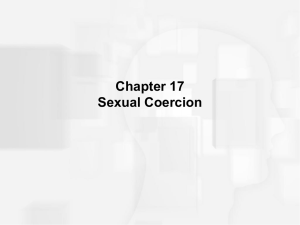
North East Conference on
Sexual Violence
22 November 2010
The protection of children against
sexual abuse and sexual
exploitation:
Exploring the UK’s ‘justice gap’
m.ohara@ salford.ac.uk
Council of Europe Convention
Article 18(1)
Each Party shall take the necessary legislative or other
measures to ensure that the following intentional conduct is
Criminalised:
a) engaging in sexual activities with a child who, according
to the relevant provisions of national law, has not reached
the legal age for sexual activities;
b) engaging in sexual activities with a child where:
- use is made of coercion, force or threats; or
- abuse is made of a recognised position of trust, authority
or influence over the child, including within the family; or
- abuse is made of a particularly vulnerable situation of the
child, notably because of a mental or physical disability or
situation of dependence.
Council of Europe Convention
Article 30
1. Each Party shall take the necessary
legislative or other measures to ensure that
investigations and criminal proceedings are
carried out in the best interests and respecting
the rights of the child.
2. Each Party shall adopt a protective approach
towards victims, ensuring that the investigations
and criminal proceedings do not aggravate the
trauma experienced by the child and that the
criminal justice response is followed by
assistance, where appropriate.
Cawson et al (2000) –
Prevalence study
• Cawson et al obtained responses from 1, 979 (69%)
of 2,869 18-24 year olds who were asked about
whether they had experienced specific sexual acts
before the age of 16
• Researchers defined the experience as abuse
where:
The respondents had not consented
The respondents were aged 12 or younger at the time
of the experience, and the other person had been more
than 5 years older
(Cawson et al, Child Maltreatment in the United Kingdom: a Study of the
Prevalence of Abuse and Neglect (NSPCC, London 2000))
Cawson et al –
Summary of findings
• 376 (19%) of the respondents had experienced
sexual abuse as defined by the researchers
Of this group:
• 5.3% had been abused by parents/carers
• 15.8% had been abused by other relatives
• 57.9% had been abused by other known people
• 21% had been abused by strangers
Estimated conviction rates:
October 2006 - March 2008
Offence
Recorded
reports to
police
(estimated)
Number of
jury verdicts
Number of
convictions
% recorded
reports
leading to
conviction
Rape of a girl
under 16
4,504
1,674
(37%)
1,037
(62%)
23
Rape of a girl
under 13
2,184
224
(10%)
129
(58%)
6
Rape of a
boy under 16
414
111
(27%)
56
(50%)
13
Rape of a
boy under 13
616
81
(13%)
60
(74%)
10
Competency requirement –
R v Wallwork (1958) 42 Cr App
R 153
Lord Goddard CJ:
‘’The court deprecates the calling of a child of
this age as a witness…the jury could not attach
any value to the evidence of a child of five: it is
ridiculous to suppose that they could. There
must be corroborative evidence if a child of
tender years and too young to understand the
nature of an oath is called, but in any
circumstances to call a little child of the age of
five seems to us to be most undesirable, and I
hope it will not occur again.’’
Example of a
corroboration warning
‘’It is well known that women in particular and
small boys are liable to be untruthful and to
invent stories.’’
(Sutcliffe J, 1976, Old Bailey trial, cited in Temkin, Rape and the Legal
Process (OUP 2002) p.257)
Legal and policy reforms
• S. 34 Criminal Justice Act 1988 – repealed requirement re
corroboration of unsworn evidence of children
• S. 54 Criminal Justice Act 1991 – allowed video-taped
evidence-in-chief to replace live evidence-in-chief
• S. 32 Criminal Justice and Public Order Act 1994 –
removed requirement for corroboration warning re
evidence of complainants at sexual offence trials
• Youth Justice and Criminal Evidence Act 1999 (YJCEA) introduced a range of special measures for child witnesses
• 2002 – publication of Achieving Best Evidence in Criminal
Proceedings: Guidance on Interviewing Victims and
Witnesses, and Using Special Measures (ABE)
Current position re competence
of witnesses
• S.53 YJCEA - everyone is competent in
principle, whatever their age
• S. 54(3) YJCEA – in considering the question of
competence, the court must bear in mind the
special measures available under the Act
R v Barker [2010]
EWCA Crim 4
‘’The question in each case is whether the individual
witness, or, as in this case, the individual child, is
competent to give evidence in the particular trial. The
question is entirely witness or child specific. There are no
presumptions or preconceptions. The witness need not
understand the special importance that the truth should be
told in court, and the witness need not understand every
single question or give a readily understood answer to
every question. Many competent adult witnesses would
fail such a competency test. Dealing with it broadly and
fairly, provided the witness can understand the questions
put to him and can also provide understandable answers,
he or she is competent.’’
Section 41 YJCEA –
Restrictions on sexual history
evidence
• S. 41(1) - defendants charged with sexual
offences cannot introduce evidence or questions
about the complainant’s sexual history except
with leave of the court
• Court may give leave only if it is satisfied that:
The evidence or questions are directly relevant to the
defendant’s case (s. 41(3)), or
The evidence or questions are necessary to enable the
evidence adduced by the prosecution to be rebutted or
explained by or on behalf of the accused (s. 41(5))
Influence of sexual history and
reputation - Kelly et al (2006)
‘’Questions of sexual history and reputation reinforce bias
and stereotypes, which in turn not only temper the urgency
to investigate thoroughly, but also have a bearing on
decisions about whether to proceed with a
case…Interviews with police officers and CPS
staff…confirmed that what are now commonplace
behaviours - being drunk, having sexual experiences
before the age of 16 (consensual and non-consensual),
and having multiple partners as an adult – were seen to
undermine a complaint of rape. These perceptions are, at
worst, a form of prejudice or, at best, legacies of centuries
of discriminatory requirements in rape law.’’
(Emphasis added)
(Kelly et al, Section 41: An evaluation of new legislation limiting sexual history
evidence in rape trials, Home Office Online Report, 2006)
Cross-examination –
Facts v impressions
‘’My tactics are to be agreeable, not to be
aggressive, to be reasonable, to ask the sort of
questions in the sort of way that a juror might
wish to ask them. You’ll put your chap’s facts
and obviously controvert her facts. They’re less
important than undermining her personality. It
sounds sinister but that’s what you’re trying to
do, make her sound and appear less credible.’’
(Barrister cited in J. Temkin, ‘Prosecuting and Defending Rape:
Perspectives from the Bar’, Journal of Law and Society, Vol. 27, No. 2,
June 2000)
Cross-examination
strategies
Q: You know quite a bit about sex, don’t you?
A: I know a bit, but not that much.
Q: Do you talk to your brother about sex ever?
A: No. I don’t see him a lot now because he has moved out.
Q: What about before he moved out?
A: No.
Q: All right. When your brother was in the park or anywhere
like that, did you ever talk to him about anything that was
sexy?
A: No. (8-year-old girl)
(Cited in H. Westcott and M. Page, ‘Cross-Examination, Sexual Abuse
and Child Witness Identity’, Child Abuse Review, Vol.11 2002)
Cross-examination
strategies - continued
Q: Let me ask you this. Over the last couple of years would this be
fair? You and your sister have been a bit out of control. Would
that be a fair thing to say?
A: What do you mean?
Q: I will tell you what I mean. I mean you have been staying out
quite late, later than your mum would like. Would that be right?
A: No. A couple of times.
Q: I do not want to get you into any trouble, but have you been
smoking a bit?
A: Yeah.
Q: And your mum does not like that, is that right?
A: Yeah, but she knew.
Q: And you have been getting drunk a bit, is that correct?
Advocates on crossexamination techniques
‘’You want them to sweat a bit…My technique is
to…extend the time for crossexamination…you’re deliberately making it as
long as possible…Tactically you want to put
them under as much pressure as possible. I
want them to crack.’’
(Barrister cited in E. Henderson, ‘Mapping the theory of crossexamination in relation to child witnesses’, in H. Westcott and G M
Davies, Children’s Testimony: A Handbook of Psychological Research
and Forensic Practice, (Wiley, Chichester 2002))
Advocates on crossexamination techniques continued
‘’When I start to cross-examine, I say something like,
shall we strike a bargain? If I am wrong, will you tell
me? And the child says yes. And if I am right, will you
also tell me? And the child says yes. That’s a
perfectly straightforward way of telling the child that I
am going to put things that the child won’t agree
with… If I make a child cry in cross-examination, I
have probably failed in the eyes of the jury…I will
also have failed in terms of my duty to the child,
because I do not believe that cross-examination,
doing your job properly, can ignore the effect of
questioning on the child.’’
(Nigel Pascoe, QC, cited in A case for balance: Demonstrating good practice
when children are witnesses, (NSPCC, London 1997))
ABE – judicial protection from
inappropriate questioning
‘’The sort of questioning likely to be ruled out is
anything that lacks relevance, or is repetitive,
oppressive, or intimidating. Questioning may be
intimidating because of its content, or because
of the tone of voice employed. An advocate may
be asked to rephrase a question if it is in a form
or manner likely to lead to misunderstanding on
the part of the witness. A young witness, or
witness with learning disabilities…may easily be
confused by questions that contain double
negatives (Is it not true that you were not
there?), or that ask two questions at the same
time (Is it true that you were there and you heard
what was said?).
ABE guidance on crossexamination
‘’Some legal representatives routinely ask young
witnesses ‘Do you tell lies?’, but this is a practice
that ought to be avoided unless the legal
representative has grounds for thinking that the
witness is an habitual liar (other than the fact
that the witness’s evidence contradicts that of
the defendant).’’
Plotnikoff and Woolfson (2009) Findings re young witnesses’
experiences of defence advocates
• 28% (49) said defence advocates were polite
• 49% (84) described them as sarcastic, rude,
aggressive, or cross
• 65% (111) reported 1 or more problems with
comprehension
• 58% (100) said the defence advocate tried to make
them say something they did not mean, or put words
in their mouth
• 57% (98) said the defence advocate accused them
of lying – 70% (69) of these said this happened more
than once
(J. Plotnikoff & R. Woolfson, Measuring up? Evaluating implementation of
Government commitments to young witnesses in criminal proceedings
(NSPCC, London 2009))
Plotnikoff and Woolfson Conclusions
‘’…the results illustrate the benefits experienced
by young witnesses when…policies are put into
practice…Overall, however, findings reveal a
significant gap between the vision of policy and
the reality of many children’s experiences. The
picture therefore remains disappointing,
particularly in respect of:
• visually recorded statements…
• assistance received before trial…
• standards of questioning at court…
• emotional support for young people while
they give evidence…’’










